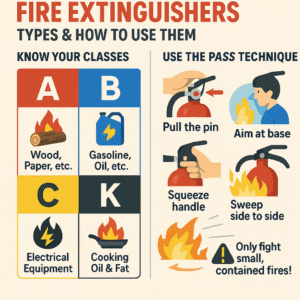Fire Safety
Fire Safety: A Complete Guide to Prevention, Protection, and Survival
Fire safety is a critical aspect of protecting lives, homes, and workplaces. Every year, fires cause devastating losses, but many can be prevented with proper knowledge and precautions. This comprehensive guide covers fire prevention, detection, extinguishing methods, escape plans, and emergency response to keep you and your loved ones safe.
Why Fire Safety Matters
Fires can spread rapidly, leading to:
Deaths and injuries from smoke inhalation and burns.
Property damage costing billions annually.
Long-term trauma for survivors.
By following fire safety best practices, you can reduce risks and save lives.

Fire Prevention Tips
Most fires are preventable. Follow these key steps:
1. Electrical Safety
Avoid overloading outlets and power strips.
Replace frayed or damaged cords.
Use surge protectors for high-wattage appliances.
2. Kitchen Safety (Leading Cause of Home Fires)
Never leave cooking unattended.
Keep flammable items (towels, paper) away from stoves.
Install a fire extinguisher nearby.
3. Smoking Hazards
Smoke outside and use deep ashtrays.
Never smoke in bed or when drowsy.
4. Heating Equipment Safety
Keep space heaters 3 feet away from flammable materials.
Have chimneys and furnaces inspected annually.
5. Flammable Liquids & Chemicals
Store gasoline, propane, and cleaning agents in ventilated areas.
Keep them away from heat sources.
Fire Detection & Early Warning Systems
Early detection saves lives. Ensure proper safety measures:
Smoke Alarms
Install on every floor, including inside and outside bedrooms.
Test monthly and replace batteries yearly (or use 10-year lithium batteries).
Replace alarms every 10 years.
Carbon Monoxide (CO) Detectors
Place near sleeping areas (CO is odorless and deadly).
Sprinkler Systems (For Businesses & Large Homes)
Automatically suppress fires before they spread.
Fire Extinguishers: Types & How to Use Them
Not all fires are the same—use the right extinguisher:
| Type | Use Case |
|---|---|
| Class A | Wood, paper, trash |
| Class B | Flammable liquids (gasoline, oil) |
| Class C | Electrical fires |
| Class K | Kitchen grease fires |

How to Use a Fire Extinguisher (PASS Method)
Pull the pin.
Aim at the base of the fire.
Squeeze the handle.
Sweep side to side.
Note: Only attempt to extinguish small fires. If it spreads, evacuate immediately.
Fire Escape Plan: How to Survive a Fire
Every second counts in a fire. Follow these steps:
1. Create an Escape Plan
Identify two exits from every room (door/window).
Designate a meeting spot outside.
Practice fire drills twice a year.
2. During a Fire
Crawl low under smoke (cleaner air is near the floor).
Feel doors before opening—if hot, use another exit.
Stop, Drop, and Roll if clothes catch fire.
Never use elevators—always take stairs.
3. If Trapped
Close doors to block smoke.
Seal gaps with wet towels.
Signal for help from a window.
Fire Safety for Businesses & Workplaces
Employers must ensure compliance with OSHA and NFPA standards:
Conduct regular fire drills.
Keep exits clear and mark escape routes.
Train employees on fire extinguisher use.
Maintain sprinkler systems and fire alarms.
Special Considerations
Children & Fire Safety
Teach kids not to hide from firefighters.
Keep lighters/matches out of reach.
Elderly & Disabled Individuals
Assign a helper for evacuation.
Install strobe light alarms for the hearing impaired.
Pets
Keep leashes/carriers near exits.
Place pet alert stickers on windows for firefighters.
Emergency Numbers (Worldwide)
-
USA/Canada: 911
-
UK: 999 or 112
-
EU: 112
-
Australia: 000
-
India: 101
-
Japan: 119
Final Thoughts: Be Prepared, Stay Safe
Fires can strike unexpectedly, but with proper prevention, detection, and response, you can minimize risks. Share this guide with family, friends, and coworkers to promote fire safety awareness.
🔥 Protect Your Home. Save Lives. Stay Safe! 🔥
